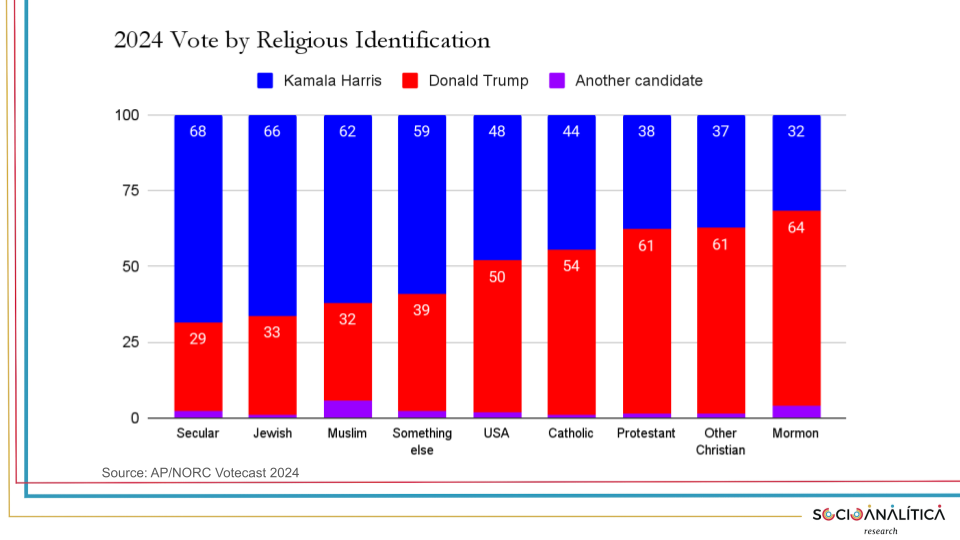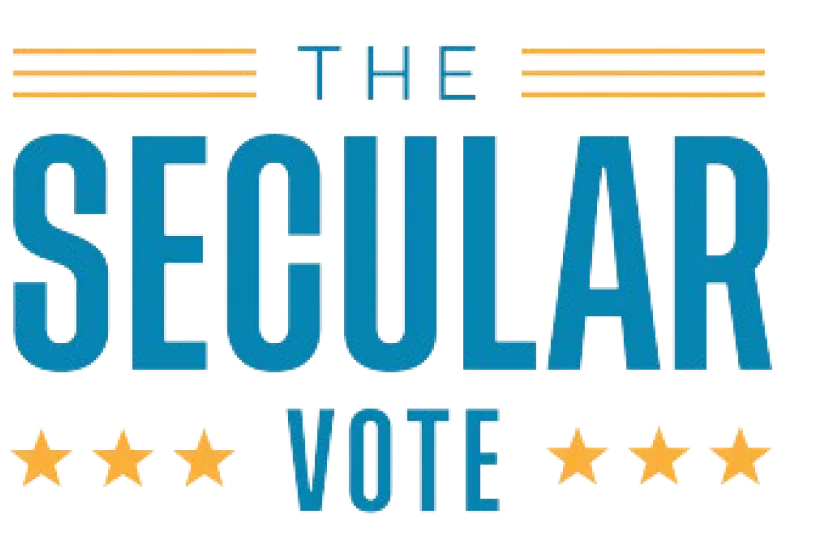[Note: This essay was originally published in Secular Politics as a three-part series between April 25 and May 9, 2025.]
The Most Democratic Leaning Religion Cohort
Last week, I attended the American Atheists Convention in Minneapolis. Aside from meeting new friends, finally meeting some online friends in person, and catching up with old friends, I had the chance to discuss some of the material I have previously published in this newsletter.. I finished my presentation with some notes for future posts. These future posts will focus on the 2024 election, primarily because several data sources related to the 2024 elections have become available in the last few weeks. Today, I will focus on the VoteCast survey conducted by the Associated Press and the National Opinion Research Center.
The VoteCast survey finds that the most likely group to vote for Kamala Harris in 2024 was the secular cohort. According to the study, 68%, or more than two-thirds, of secular voters cast their ballots for Kamala Harris. About three-in-ten (29%) voted for Donald Trump. Among religion groups that voted a majority for Kamala Harris, the secular cohort is by far the largest. This aligns with my previous post following the election, which found that the Exit Polls suggested the secular cohort was the only one that didn’t budge significantly in terms of its support for the Democratic presidential candidate.
As shown in the chart, approximately two-thirds of secular voters and Jewish voters supported Kamala Harris. That is in line with their historical pattern, especially in this century. About six-in-ten Muslim voters and voters who belong to other religions also voted for Harris. By contrast, majorities of groups identified as Christians voted for Donald Trump in 2024. The lowest proportion was 54% of Catholics, increasing to 64% among Mormons. Among white Evangelical Christians, 76% voted for Trump (not shown). This is higher than any other group, but the survey’s measurement of “born again/evangelical” is confusing, so I excluded it from the chart.
The Largest Religion Cohort in the Democratic Coalition
In our last issue, we examined the role of secular voters (Americans who identify with no religion) in the 2024 election. The data revealed something striking, though not surprising: secular voters were the strongest supporters of Kamala Harris. Over two-thirds (68%) of them backed her, making this group more supportive of a Democratic presidential candidate than any other religious or non-religious cohort.
When we examine their voting behavior more closely, we see that secular voters weren’t just enthusiastic Harris supporters; they made up nearly one-third of her total voter base. Data from the 2024 VoteCast survey, conducted by the Associated Press and NORC, show that 31% of all Democratic voters identified as non-religious.
In contrast, only about 13% of Trump voters identified as secular. This means non-religious Americans are significantly overrepresented among Democratic voters and underrepresented among Republicans, despite comprising roughly one-in-five (22%) voters in the VoteCast sample; less than one-in-six Republican voters identified as secular.
This divide is consistent with a trend that has been ongoing since the 1990s. The Democratic Party has increasingly drawn support from the secular population, while the GOP has leaned heavily into Christian identity politics. As Republicans double down on anti-science rhetoric, religious nationalism, and culture war messaging such as transphobia, race essentialism, and opposition to diversity programs, secular voters are largely rejecting that agenda.
Still, secular voters are not a political monolith. About three-in-ten voted for Trump in 2024. We don’t have detailed data about how these voters identify within the secular spectrum, whether as atheists, agnostics, or simply “nothing in particular.” The VoteCast captures only religious affiliation, not belief in the supernatural or church attendance, so we do not know how religious beliefs and practices affected the secular vote last year.
It’s also important to remember that many secular Americans identify as political independents. Historically, this group has shown weak attachment to either party. Yet despite self-describing as independents, they consistently lean Democratic, not out of party loyalty, but often because the GOP is openly antagonistic to their values.
This is a pattern we’ve seen with other marginalized groups as well. Just as many Black or Latino voters support Democrats while expressing frustration with party inaction, secular voters may vote blue more as a defensive measure than a full endorsement. The Democratic Party, while more welcoming to secular ideas, still struggles to engage and represent these voters actively.
The Cohesion of the Secular Vote
We have focused on secularism and the secular vote in 2024 for the past couple of weeks. We’ve established two key points: First, secular voters are the most likely to support Democratic candidates, in this case, Kamala Harris. Second, seculars represent the largest religious cohort within the Democratic electorate today. Nearly one-third of Democratic Party voters in 2024 are secular, and two-thirds of secular voters supported Kamala Harris.
This week, we’re delving into the diversity of the secular vote by analyzing the three largest religious affiliation groups based on race to uncover any trends. Unsurprisingly, Black Protestants and White Protestants have different voting behaviors; however, since White Protestants are a larger segment of the population, their strong support for Trump influences the overall Protestant vote. Similar patterns exist among Latino (Democratic-leaning) and White Catholics (Republican-leaning).
The chart below breaks down how various racial and religious groups voted for the Democratic Party in 2024, based on AP/NORC Votecast data. The data are categorized by race (White, Black, Latinx, Asian) and further segmented into the three largest religious identity cohorts: Protestant/Other Christian, Catholic, and Secular.
Among White voters, support for the Democratic Party is the lowest across Christian identity cohorts, with only 28% of White Protestants and 39% of White Catholics voting Democratic. By contrast, two-thirds (67%) of White secular voters supported the Democratic Party, highlighting a significant religious divide.
Black voters demonstrate overwhelming support for the Democrats regardless of religious affiliations, with minimal variation: more than eight-in-ten Black Protestants (84%), Black Catholics (81%), and Black secular (81%) voters cast their votes for Kamala Harris. This data reveals a strong political cohesion among Black voters, regardless of their religious identity.
Latinx voters show a wider range of Democratic support: fewer than four-in-ten (39%) Latinx Protestants voted for Harris, the only major cohort among people of color where a majority voted for Trump. Most (57%) Latinx Catholics and seven-in-ten (70%) secular Latinx voters supported Harris. The majority of Asian voters supported Harris, with 59% of Asian Protestants, 52% of Asian Catholics, and 72% of secular Asian voters.
Overall, the chart highlights two key trends: secular voters across all racial groups are significantly more likely to vote Democratic, and black voters remain the most unified bloc in their support for the Democratic Party, regardless of religious affiliation.
Secular voters are most likely to vote for Democrats, demonstrating unity across racial lines. White secular Americans are the only group of Whites that consistently votes for Democrats. Secular voters exhibit a level of unity similar to that of Black Americans, which is remarkable.
As we consider how to rescue U.S. democracy, if that is even possible, we must acknowledge the significance of secular Americans as a political force. While I am not suggesting that there are no racist individuals within this group, generally, they tend to be more open to a pluralistic society and more supportive of social equality than their Christian counterparts. They are also more accepting of diverse religious beliefs, unlike those professing Christian Nationalism.
What we are witnessing is a coalition of secular Americans alongside others who are not Christian, working against the Christian supremacy represented by the Republican Party. A few months ago, in my blog post for Kettering Foundation’s “From Many, We,” I suggested that there is an increasing support for Christians of color for Trump and a growing acceptance of Christian nationalism. This is a significant issue that aligns with the data we are seeing.
It’s encouraging that the recent political shifts did not impact secular individuals as heavily as they did other Christian groups. This presents an opportunity for us to begin rebuilding, not just restoring democracy and creating a “more perfect union” that takes secular Americans seriously as a political force. We must consider their views on diversity and pluralism as fundamental to revitalizing a small-d democratic culture that genuinely embraces democracy.


